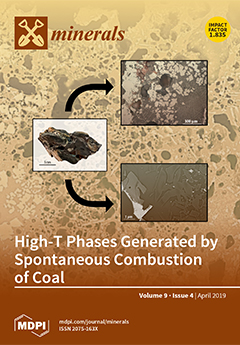Tsikourasite, Mo
3Ni
2P
1+x (
x < 0.25), is a new phosphide discovered in a mantle-hosted podiform chromitite collected in the abandoned mine of Agios Stefanos (Othrys ophiolite), Central Greece. It forms tiny grains (from a few μm up to about 80 μm) and occurs as isolated grains or associated with other known minerals such as nickelphosphide and awaruite, and with undetermined minerals such as Ni-allabogdanite or Ni-barringerite and a V-sulphide. Tsikourasite is brittle and has a metallic luster. In plane-polarized light, tsikourasite is white yellow and it shows no bireflectance, anisotropism or pleochroism. Internal reflections were not observed, Reflectance values of tsikourasite in air (
R in %) are: 55.7 at 470 nm, 56.8 at 546 nm, 57.5 at 589 nm and 58.5 at 650 nm. Five spot analyses of tsikourasite give the average composition: P 7.97, S 0.67, V 14.13, Fe 14.37, Co 7.59, Ni 23.9, and Mo 44.16, total 99.60 wt.%, corresponding to the empirical formula (Mo
1.778V
1.071Fe
0.082Co
0.069)
Σ3.000(Ni
1.572Co
0.428)
Σ2.000(P
0.981S
0.079)
Σ1.060, on the basis of Σ(Mo +V + Fe + Co + Ni) = 5 apfu and taking into account the structural results. The simplified formula is Mo
3Ni
2P
1+x (
x < 0.25). The density, which was calculated based on the empirical formula and single-crystal data, is 9.182 g/cm
3. The mineral is cubic, space group F-43m, with
a = 10.8215(5) Å and
Z = 16. Although tsikourasite is similar in composition to those of monipite (MoNiP), polekhovskyite (MoNiP
2), and the synthetic compound MoNiP
2, all these phases are hexagonal and not cubic like tsikourasite. It exhibits the same structure as the cubic Mo
3Ni
2P
1.18 compound [space group F-43m, a = 10.846(2) Å] synthesized at 1350 °C. The mineral and its name have been approved by the Commission of New Minerals, Nomenclature and Classification of the International Mineralogical Association (No. 2018-156). The mineral honors Professor Basilios Tsikouras of the Universiti Brunei Darussalam.
Full article





